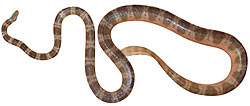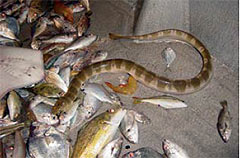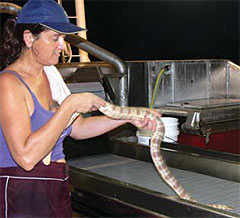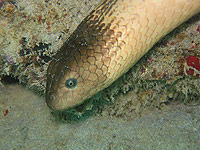
|
||||||||
|
When venomous sea snakes are caught in prawn nets, fishing crews try to return them to sea as quickly as possible. But being caught by a trawl can also be perilous for the sea snakes themselves. Sea snakes must surface regularly to breathe and may drown if caught in a trawl net.
There are more than 30 types of sea snake in Australian waters and they are all protected species. CSIRO fisheries ecologist, Dr David Milton, works with skippers and crews, scientific observers and fishery managers in the Northern Prawn Fishery (NPF) to understand the risk trawling poses to sea snakes, and to help reduce their capture. In research funded by the Fisheries Research and Development Corporation and in partnership with the Australian Fisheries Management Authority, Dr Milton looks at how likely sea snake species will be caught, and the capacity of populations to withstand many deaths. For example, sea snakes that live in soft, muddy sediments typical of prawn trawl grounds are more likely to be caught than ones that live outside trawl areas, such as on reefs. Other factors affecting their capture include diet and feeding times. |
 Large sea snake species are particularly long-lived, so their populations are the slowest to recover. Larger sea snakes are also less likely to survive in trawl nets. The large, bulky, olive sea snake (Aipysurus laevis) has a limited capacity to survive capture. (courtesy CSIRO Marine and Atomospheric Research) |
“Most sea snakes tend to dwell amid reef structures, but venture out to forage in open muddy habitats, the kind of areas favoured by prawns,” Dr Milton says.
“They’re not very fast so they find it easier to catch things that live down holes, such as eels and gobies, or fish eggs in nests.”
 (courtesy CSIRO Marine and Atomospheric Research) |
As well as being vulnerable to capture, sea snake populations may be slow to recover from trawling. “Sea snakes are slow-growing and produce a few young each year, weighing up to 40 per cent of the mother’s weight (compared with about 5% in humans and most fish). So their populations will decline if a high proportion of mothers and young do not survive,” Dr Milton says. Dr Milton says all trawlers in the NPF use bycatch reduction devices (BRDs), special openings made in trawl nets to prevent the capture of non-target species. Trials are being carried out on commercial vessels to see which BRDs, and which configurations, are most effective at excluding sea snakes. |
Dr Milton also studies records gathered by crew members and scientific observers to see whether sea snake populations are sustainable. He says the good news is that a gradual reduction of vessel numbers in the fishing fleet has contracted trawling to more productive prawn areas, thereby lessening pressure on sea snakes. At this stage, no species appears particularly vulnerable. Nevertheless, ongoing measures are being taken by the fishery to ensure sea snake capture and populations are monitored. As part of this strategy, crew member observers with a special knowledge of sea snake species will make scientific observations at sea. Find out more
|
 Crew members with a special knowledge of sea snake species will contribute to future scientific monitoring programs. (courtesy CSIRO Marine and Atomospheric Research) |
Acknowledgements This information sheet has been compiled using the expertise and support from CSIRO Marine and Atmospheric Research. |
 Olive sea snake (courtesy Phil Hartnell via Flickr) |
